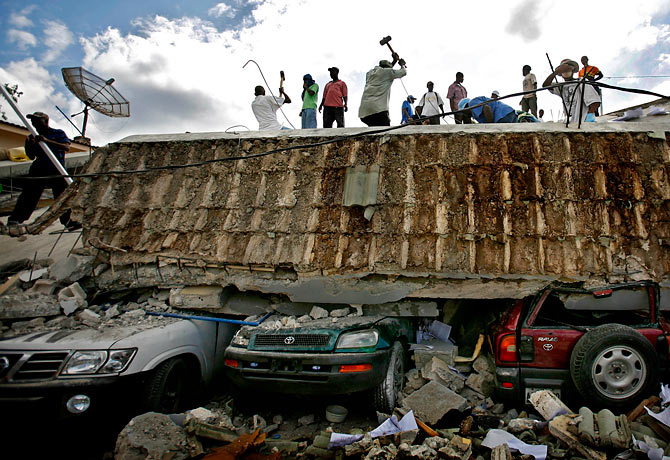
People search for earthquake survivors under the rubble of a collapsed building in Port-au-Prince, Haiti, on Jan. 13, 2010
When an earthquake ravages a country as poor and urbanized as Haiti, it produces the cruelest kind of synergy, as poverty breeds cramped living quarters that are left even more vulnerable by substandard construction work. While U.S. officials weren't issuing estimates of casualties from Tuesday's strong 7.0 earthquake, there was growing concern that pancaked buildings in Port-au-Prince, home to some 2 million people — and Haiti's inability to quickly rescue those who are trapped — could lead to thousands, if not tens of thousands, of fatalities.
The U.S. response began with a Navy P-3 Orion based at Comalapa, El Salvador, which flew over the Haitian capital gathering photographic and other intelligence on the extent of the damage. Officials at the Miami-based U.S. Southern Command began using that information to guide U.S. and international rescue efforts. At first light on Wednesday, a Coast Guard helicopter evacuated four critically injured U.S. embassy staff and took them to a hospital at Naval Station Guantánamo Bay, Cuba, for treatment. Elements of the Air Force First Special Operations Wing deployed on Wednesday to the international airport at Port-au-Prince to provide air traffic control capability and airfield operations.
Pentagon officials said an initial team of 30 people arrived in Haiti on Wednesday to join the 63 U.S. soldiers who are permanently stationed there. The team includes military engineers, operational planners, communication specialists and a command and control group. They'll work with U.S. embassy staff as well as Haitian, U.N. and other officials on the ground to assess the situation and coordinate rescue and recovery efforts. The Navy aircraft carrier U.S.S. Carl Vinson is on the way and is expected to arrive off the coast of Haiti on Thursday, where it will be joined by additional Navy vessels that are under way.
As many as 2,000 Marines could soon be deployed to the island, General Douglas Fraser, U.S. Southern Command chief, told a Pentagon briefing on Wednesday. While "the situation is calm" on the island, Fraser said, the forces could ensure that it stays that way as the humanitarian situation potentially grows more dire. An Army brigade of about 3,000 troops at Fort Bragg, N.C., has also been put on alert for possible deployment.
Fraser made clear, when pressed on reports that 100,000 or more people may have perished, that just as there is a "fog of war," there is also a fog surrounding natural disasters. "You've heard reports of collapsed buildings, but there's been very limited communications," he said. "I think there will be significant loss of life."
Beyond providing security, the U.S. military's goal is to make sure that airports and seaports are primed to receive the flood of aid that is expected to flow into Haiti in the coming days. Initial reports from the airport indicated that its runway is functional but that the control tower has no communications and the passenger terminal is damaged.
U.S. forces will be setting up command centers, linked by the U.S. military's communication networks, to replace those that were ripped apart by the quake. The Pentagon may also dispatch the hospital ship U.S.N.S. Comfort from its homeport in Baltimore to the region as well as fleets of Coast Guard vessels and aircraft. The Comfort last visited Haiti in April, the first stop during its four-month Continuing Promise 2009 humanitarian-assistance mission through Latin America and the Caribbean. Its crew of medical professionals from the Navy, Army, Air Force, Coast Guard and U.S. Public Health Service, as well as about a dozen nongovernmental organizations and international partners, provided a full range of medical care to Haitian citizens.
The Comfort may in fact not be needed, because the large vessel ferrying many of the Marines to Haiti has much of the same medical capability.
"The United States is going to do all we can to help, and we've worked throughout the night to figure out how we can do that and do it as rapidly as possible," Admiral Mike Mullen, Joint Chiefs of Staff Chairman, said on Wednesday. "We have an awful lot of people working in that direction right now."
The U.S. military most recently helped out in Haiti in September 2008, after a series of hurricanes left flooding and mudslides in their wake. The U.S.S. Kearsarge, an amphibious ship on a humanitarian mission in Colombia at the time, was diverted to Haiti, where its crew remained for 19 days, using helicopters and amphibious landing craft to deliver 3.3 million pounds of internationally donated aid to communities that were isolated by the disaster.
"Thousands of people are hard at work in our government trying to do everything we can," Under Secretary of State Ellen Tauscher said on Wednesday morning, adding that Haiti's "woeful infrastructure ... is making it very difficult for us to even understand how to get there and help them." Secretary of State Hillary Clinton, on a nine-day tour of the western Pacific, was "up all night" in Hawaii helping coordinate the Obama Administration's rescue efforts, Tauscher said. "This is a very big tragedy," she added, "but we're all working hard to make sure that we can deliver the kind of aid and support [Haiti needs] — and our condolences too."